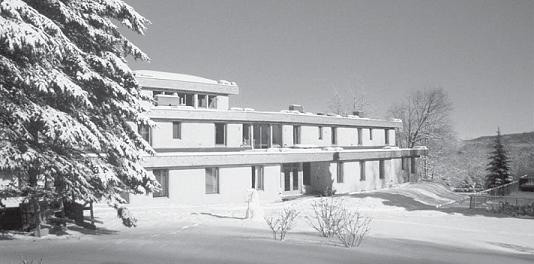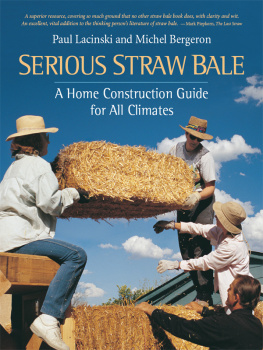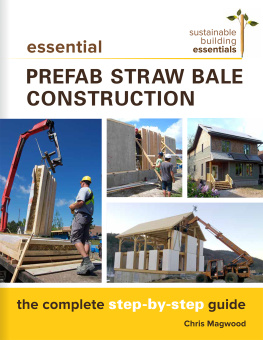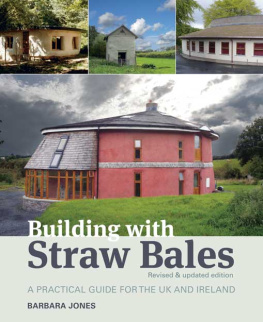SERIOUS STRAW BALE
SERIOUS STRAW BALE
A Home Construction Guide for All Climates
Paul Lacinski and Michel Bergeron
CHELSEA GREEN PUBLISHING COMPANY
White River Junction, Vermont
Copyright 2000 by Paul Lacinski and Michel Bergeron.
Unless otherwise noted, photographs are copyright 2000 by Michel Bergeron,
Paul Lacinski, and Amy Klippenstein.
Illusirations copyright 2000 Michael Middleton.
All rights reserved. No part of this book may be transmitted in any form by any means without permission in writing from the publisher.
Designed by Andrea Gray.
Cover by Ann Aspell.
Printed in Canada.
First printing, October 2000.
10 9 8 7 6 5 4
Printed on acid-free, recycled paper.
Due to the variability of local conditions, materials, skills, site, and so forth. Chelsea Green Publishing Company and the authors assume no liability for personal injury, property damage, or loss from actions inspired by information in this book. Remember that any construction process can be dangerous. Moreover, because building codes in most areas do not yet address the practice of straw bale construction, and because each new straw bale building may serve as an example and prototype for others, it is especially important that builders approach their work with due caution, care, and a sense of responsibility.
Library of Congress Cataloging-in-Publication Data
Lacinski, Paul, 1967
Serious straw bale: a home construction guide for all climates/Paul Lacinski and Michel Bergeron.
p. cm. (The Real Goods solar living books)
Includes bibliographical references.
eBook ISBN: 978-1-60358-208-7
1. Straw bale housesDesign and construction. I. Bergeron, Michel. 1946- II. Title. III. Real Goods solar living book.
TH4818.S77 L33 2000
693'.997dc21 00-058943
Chelsea Green Publishing Company
Post Office Box 428
White River Junction, VT 05001
(800) 639-4099
www.chelseagreen.com
CONTENTS
PART 1
Straw Bale Buildings in Perspective
PART 2
Straw Bale Structures
PART 3
Straw Bale Finishes
PART 4
Straw Matters
T HIS IS A BOOK ABOUT WALLSabout how to design and build beautiful (and hopefully durable) walls of bales and plaster. It is written with one intention, to provide you with the background necessary to think your way through a straw bale project even in an extremely cold and/or wet climate. It is emphatically not a book that aims to prescribe one best way of doing things; part of what is exciting about bale and plaster walls is that they are not yet (and perhaps never will be) streamlined into a one-size-fits-all system.
This is also not a book about the general topic of building design. Materials are only a small portion of good design; they are subservient to the many interlocking issuesthe needs of the occupant, aesthetics, energy use, site, structure, and budget among themthat weave a design program. This book does not attempt to lead the reader through all the stages of this intricate process. Many good books already do that. Instead, it looks at design issues from the specific perspective of the straw bale builder, and at each turn, offers strategies for how to integrate these types of walls into the larger process of design.
The central text of this book revolves around design issues. We hope these will be of use to anyonearchitect, builder, owner-builder, Renaissance womanwho is thinking about how best to detail a bale-walled building. Some issues that are primarily the concern of owner-builders are covered in sidebars, as are some construction issues. Part 1 of the book, and most notably chapter 3 (Plans, Permits, and Project Management) is written with owner-builders particularly in mind.
Wherever possible, we have offered our opinion on the efficiency of a particular method or durability of a particular detail. You must understand that while we (and the many others who have contributed ideas to this book) have been at this work for some time, we dont have all the answers to all the questions about straw bale construction. Much experimentation, systematization, and testing remains to be done. The goal of this book is to supply you with the best of the tools now available, so that you may begin to participate in this process. We hope the material that follows is useful to you, and that your bale adventure is as fun and rewarding as ours has been.

All building sites produce waste. On a straw bale construction site, the waste straw can be used as mulch!
Keep
those Bales
Dry!
T he basic principles of bale construction, especially crucial in cold and/or wet climates, can be broken down as follows. Each of these is explored in substantial detail in later chapters, but just to start off with the big picture, weve herded them all together, here. The overriding design goal in straw bale construction is: Keep those bales dry! The way to accomplish that goal is to consider these elements:
Siting
The site, which includes climate, local landforms, vegetation, and the character of the neighborhood, is the number one factor that determines whether bales are a good choice for a wall material, and how they should be finished.
Architectural Features
Precipitation is the greatest threat to bale walls; to a certain degree, site features can be ameliorated by roof overhangs, porches, connected sheds, and other features that help protect the walls from rain and snow.
Isolation from Ground Moisture
Bales should be held at least as far from finished grade as specified by the local code minimum for wood. They must also be protected from moisture that can make its way up through the foundation.
Flashing Details
Flashing and dripsills are crucial to prevent concentrated volumes of water from leaking into and sheeting down the wall.
Choice of Finish
There is no standard finish for straw bale walls. Choice of finish is an act of balance between the structural strength of more rigid materials and the higher drying potential and reduced cracking of more flexible materials.
Vapor-Permeable Construction
Whenever possible, those materials that are more vaporpermeable are a safer choice than those which are less so. In cold climates, this is especially true on the exterior.
Airtight Construction and
Mechanical Ventilation
Airtight construction and mechanical ventilation ensure good indoor air quality, reduce energy use, and control interior humidity levels, thereby greatly reducing interior moisture sources as a potential threat to bale walls.
Moisture Sensors
Without sensors, there is no way of knowing what is really going on inside the walls over the long term. All new bale houses should have at least a few, as insurance against moisture problems, and to allow residents to contribute to the body of knowledge about building with straw bales.

Straw bale techniques are becoming popular in the north even for large buildings.
I n the ever-growing field of information and experience from which this book has emerged, a special acknowledgment must go out to all those anonymous heroes of harsh climate construction who have, against the better judgment of their neighbors, built their own houses with this oddball material known as straw. Squaring off to uncertainties about its appropriateness, these faithful souls continue to pour out a stream of new details and techniques, forever refining bale construction to meet the demands of their local conditions. Without their invaluable contributions, the authors and the several other bale enthusiasts whose names appear in this book would have needed many lifetimes of experimentation in order to access such a pool of creative ideas.









